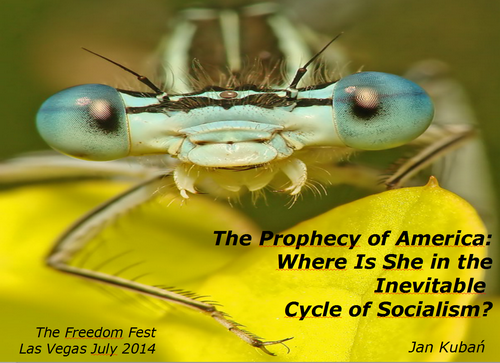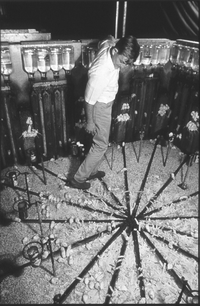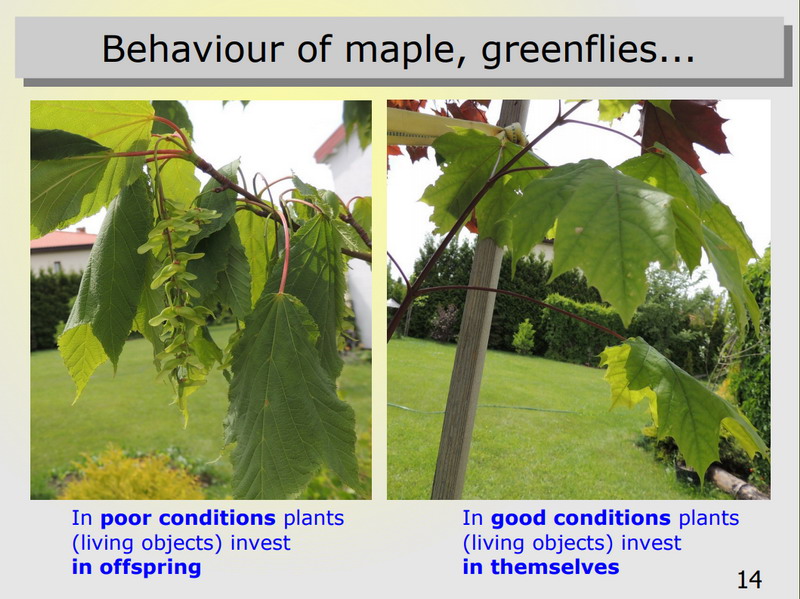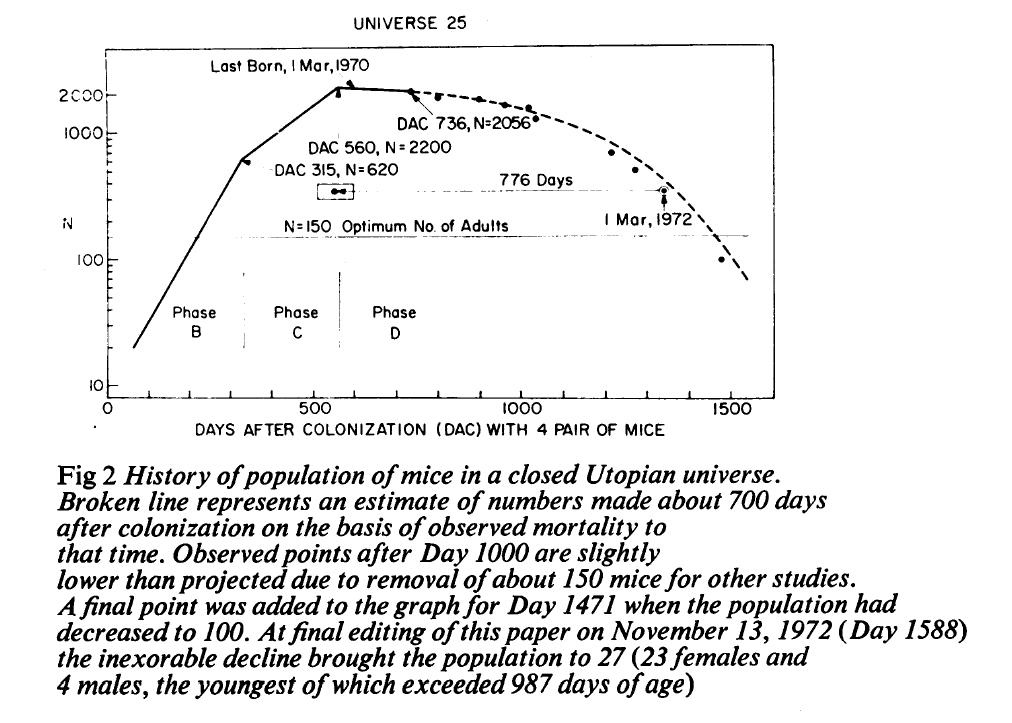John Calhoun's experiment
Calhoun's experiment - introduction

|
Eight mice given perfect living conditions with everything they needed. The population rose, fell and became extinct within 4 years. It was repeated several times using mice and rats and the results were the same:
This was John Calhoun's deepest concern - I shall largely speak of mice, but my thoughts are on man,…. This is one of the most enlightening works concerning the depths of human nature, so all available information has been collected here.
|
Calhoun's experiment - original description

1. The original study of John Calhoun:
[Original copy of this work at http://www.ncbi.nlm.nih.gov]
2. Description in Wikipedia [2014.05.25]:
In July 1968 four pairs of mice were introduced into the Utopian universe. The universe was a 9-foot (2.7 m) square metal pen with 54-inch-high (1.4 m) sides. Each side had four groups of four vertical, wire mesh "tunnels". The "tunnels" gave access to nesting boxes, food hoppers, and water dispensers. There was no shortage of food or water or nesting material. There were no predators. The only adversity was the limit on space.
Initially the population grew rapidly, doubling every 55 days. The population reached 620 by day 315, after which the population growth dropped markedly. The last surviving birth was on day 600. This period between day 315 and day 600 saw a breakdown in social structure and in normal social behavior. Among the aberrations in behavior were the following:
- expulsion of young before weaning was complete,
- wounding of young,
- inability of dominant males to maintain the defense of their territory and females,
- aggressive behavior of females,
- passivity of non-dominant males with increased attacks on each other which were not defended against.
[Wikipedia 2014.05.25]
3. Transcript from the film Mouse Utopia Experiment on Youtube:
In a unique experiment that took years to complete, Doctor Calhoun used white mice to study population growth and its effects on individual behaviour.
In this sixteen cell mouse habitat, utopian conditions of nutrition, comfort and housing were provided for the potential population of over three thousand mice. […] Factors which normally control population growth such as predation by owls and cats were eliminated. Transmissible disease were also reduced. In effect, the mouse universe simulated the present situation of the continually expanding population of humans.
To see how Dr Calhoun's mouse universe grew, we use the familiar population graph again. Within the first one hundred days, the mice went through the period Dr Calhoun called, "strive". This was the period of adjustment. Territories were established and nests were made. The next period lasted about two hundred and fifty days. The population of the mice doubled every sixty days. This was called the "exploit" period. The use of resources become unequal. Although each living unit was identical in structure and opportunities, more food and water was consumed in some areas. As the population increased, most mice associated eating and drinking with the presence of others. And crowding developed in certain units. The third period, consisting of three hundred days, found the population of mice leveling off. This was called the "equilibrium" period. Dr Calhoun noticed that the newer generations of young were inhibited, since most space was already socially defined.
At this time, some unusual behaviour become noticeable. Violence become prevalent. Excess males strived for acceptance, were rejected and withdrew. Huddling together, they would exhibit brief flurries of violence amongst themselves. The effects of violence became increasingly visible. Ceratin individuals became targets of repeated attacks. These individuals would have badly chewed and scarred tails. Other young mice growing into adulthood exhibited an even different type of behaviour. Dr Calhoun called these individuals "the beautiful ones". Their time was devoted solely to grooming, eating and sleeping. They never involved themselves with others, engaged in sex, nor would they fight. All appeared as a beautiful exhibit of the species with keen, alert eyes and a healthy well-kept body. These mice, however, could not cope with unusual stimuli. Though they looked inquisitive they were, in fact, very stupid.
Dr Calhoun called the last period the "die" phase, leading the population into extinction. Although the mouse utopia could house 3000, the population began to decline at 2200. In the shift from the equilibrium to the die phase, each animal became less aware of associates, despite all animals being pushed closer together. Dr Calhoun concluded that the mice could not effectively deal with the repeated contact of so many individual. The evidence of violence increased to the point where most individuals had had their tails bitten to some degree. Eventually, the whole mouse population perished.
[…]
The larger the population, the less care a mother gives to her nest and young.
4. Part-transcript from the film "Critical mass":
Link to the most important part of the movie "Critical mass" conected with the Calhoun's experiment.
Calhoun's experiment - important insights

|
Conditions of the mouse utopia
|
|
|---|---|
|
|
|
Phase A - The phase of social adjustment (strive period)
|
|
| Duration | The important insights |
|
Day 1 - introduction of 4 males and 4 females |
|
|
Phase B - The phase of most rapid growth (exploit period)
|
|
|
Day 105 - rapid population growth |
|
|
Phase C - The stagnation phase (equilibrium period)
|
|
|
Day 315 - slow population growth |
|
|
Phase D - The death phase (die period)
|
|
|
Day 560 - negative population growth |
|
Calhoun's experiment - conclusions

All conclusions drawn by socialist (& state) scientists constantly connect extinction with overpopulation:
The conclusions drawn from this experiment were that when all available space is taken and all social roles filled, competition and the stresses experienced by the individuals will result in a total breakdown in complex social behaviors, ultimately resulting in the demise of the population.
[Wikipedia 2014.05.25]
However in the Calhoun's papers there are clear evidences that this is not so:
- all available space was not taken
- WM (Withdrawn Males) had no social roles so they withdrew
John Calhoun conclusions:
-
The demise of a population contradicts prior knowledge which indicates that when a population declines to a few remnant groups, some individuals will reinitiate its growth.
-
Dr. Halsey Marsden (1972) placed some mice from the mid-third of phase D into new universes at very low densities. all exhibited nearly total loss of capacity for developing a structured society or for engaging in the full repertoire of reproductive behaviours.
-
For an animal so simple as a mouse, the most complex behaviours involve the interrelated set of courtship, maternal care, territorial defence and hierarchical intragroup and intergroup social organisation. When behaviours related to these functions fail to mature, there is no development of social organisation and no reproduction. As in the case of my study reported above, all members or the population will age and eventually die. The species will die out. For an animal so complex as man, there is no logical reason why a comparable sequence of events should not also lead to species extinction. If opportunities for role fulfilment fall far short of the demand by those capable of filling roles, and having expectations to do so, only violence and disruption of social organisation can follow. Individuals born under these circumstances will be so out of touch with reality as to be incapable even of alienation. Their most complex behaviours will become fragmented. Acquisition, creation and utilisation of ideas appropriate for life in a post-industrial cultural-conceptual-technological society will have been blocked. Just as biological generativity in the mouse involves this species' most complex behaviours, so does ideational generativity for man. Loss of these respective complex behaviours means death of the species.
John Calhoun's collaborator's conclusions:
- The larger the population, the less care a mother gives to her nest and young.
Non-academic conclusions drawn by people educated in life:
|
Principle conclusions:
|
The lack of challenges gradually spoils the behaviour of subsequent generations of a population. This degeneration is inevitable and leads to eventual self-extinction. Due to the lack of challenges, the extinction of a population is inevitable. It lasts several generations, but is inexorable. |
The inbreeding issue

-
As I read the description of the experiment, I noticed that the degenerative effect of inbreeding was not taken into account, which could explain the 100% mortality at it's end. Inbreeding can result in physical and mental degeneration, infertility and destructive behaviour. This has been shown in royal lineage and isolated wolf packs.
It is a very interesting phenomenon, and needs to be researched in the context of this experiment. It is only then when the experiment, in my eyes, will be complete and important from the scientific perspective.
Zofia D-J (Szwecja) 2015.09.25It is not necessarily the case. In Lucas Bridges' book "The Uttermost Part of the Earth", small islands belonging to the archipelago of the Land of Fire were inhabited by 2-3 pairs of rabbits:
On some of these boat trips Father took passengers of a different species. In the Beagle Channel, and others farther south, there are innumerable islands, mostly rocky, but with a good deal of bush, grass and wild celery growing on them. Father realized that these islands, if stocked with rabbits, would yield welcome food for natives and for any shipwrecked crews who might be stranded there. Accordingly, he brought some rabbits from the Falklands. He took good care that they did not escape onto the main island, nor did he release them on the larger islands in the Channel, lest they should become a pest to future farmers. But on any small island that he considered suitable he would land two or three pairs. Where there was good sandy soil and bush they thrived and increased exceedingly. Some years later H.M.S. Sirius anchored off one of these islands, and the whole ship’s company landed in two batches on consecutive days. Hunting the descendants of the couple of pairs set free there by my Father provided them with plenty of exercise, and over six hundred rabbits were caught – one for every man on the ship.In Calhoun's experiment 4 pairs were used, yet Lucas Bridges mentions 2-3 pairs. Because he was alive from 1874-1949, there is no way he would ever have heard about John Calhoun (1917-1995) and his experiment from 1968-1972.
According to Lucas Bridges, rabbit populations initiated by 2-3 pairs will, after a few decades and in a natural environment, develop large populations very quickly.
-
Reconstruction of the species of European bison.
As a result of genetic testing of the possibility of reproduction of the endangered european bison, scientists came to the conclusion that only six individuals were to be used for the reconstruction of the species. These six bison are, therefore, the ancestors of all lowland european bison living today.
[Source: http://www.bialowieza-info.eu/pl/zubr.php] -
The last four wild oryxes were captured in 1968 and a breeding herd was established on one of the private islands of Sheikh Zayed. Today, it has over 500 members of the herd and is constantly growing. - Norman Davies "Beneath Another Sky. A Global Journey Into History"
Calhoun's experiment - links

-
Quotes from various books related to John Calhoun's experiment
-
Mouse Utopia Experiment on Youtube [39 716 in 2014.05.25]
-
Does Calhoun’s Shocking Experiment Reveal the Condition of Our Society?
-
Talk by Jan Kuban The Prophecy of America: Where Is She in the Inevitable Cycle of Socialism? presented at the Freedom Fest in July 2014.
Sound recording of this presentation.

-
"Physiological Mammalogy", William V.Mayer, Richard G. van Gelder
Calhoun's experiment - Questions & Answers
-
Helene O. Netherlands:
I have not found the answer as to why the population would completely die out after the growth has come to a standstill and starts to decline. Why does it not go up again at a certain point? Can you shed any light on this?
Sophisticated living objects are born with a given structure and given basic behavioural patterns due to its DNA. Moreover, they are equipped with the possibility of acquiring new skills. The neonate has the opportunity to learn from the parents, the environment and the community. This learning encapsulates the essential behaviours of their own and their offsprings survival.
Firstly, they learn how to feed - in John Calhoun's study, due to effortless provision, the youngsters did not learn this. So they could not learn how to act pursuantly. If they are not able to acquire food, they cannot acquire other things, like a partner, community etc.
Secondly, the subsequent generations did not learn what they should do gradually, from generation to generation, they became worse and worse teachers. This led to a total loss of breeding, because children gradually lost their knowledge of bringing up their offspring and how to get a partner.
Initial survival, understood as survival of myself, is due to DNA. The survival of more sophisticated species depends on nurturing acquired from those around us. Scientists call these MEME's. The study shows how MEMEs degenerate causing extinction.
Creatures with higher cognitive abilities would be able to restart their normal pursuant life, provided the degeneration is not deep enough and they have to fight to survive. The mice in Calhoun's experiment had no such an opportunity to resurrect their community.


